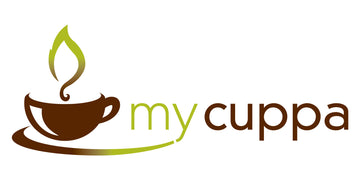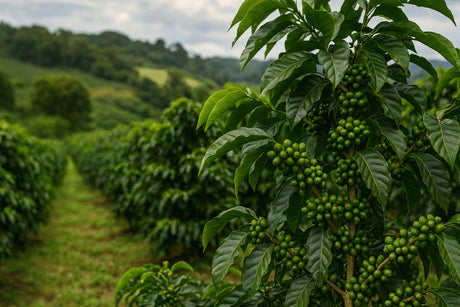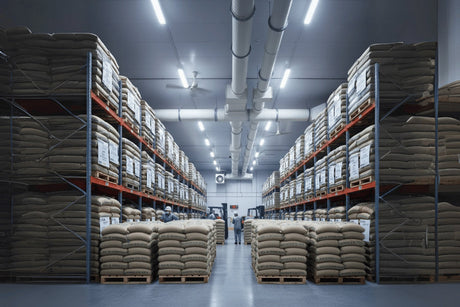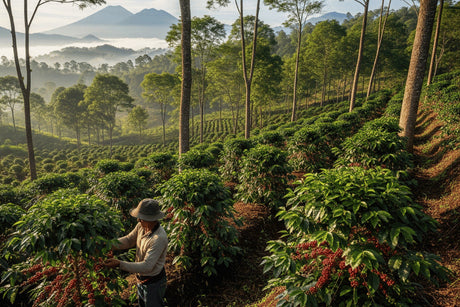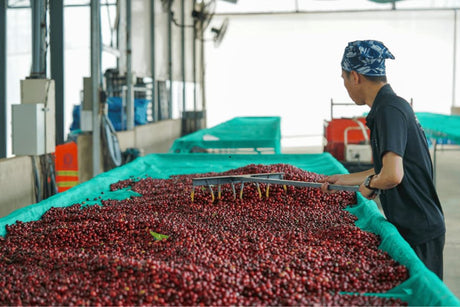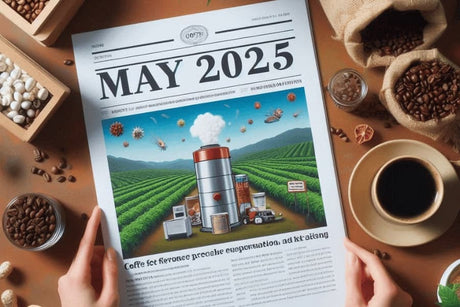mycuppa June 2015 Newsletter
Centre Way - hitting the flavour target
For 18 months, we have written about a different Single Origin as our monthly feature coffee.
There are, of course, coffee origins remaining that are yet to make it onto our newsletter - some of them are real standout performers like Sumatra, Kenya and the famous offerings of Ethiopia such as Sidamo, Yirgacheffe, Harrar, etc.
We thought it would make an interesting change this month to explore a blend.
Not just any blend, but something quite new and exciting.
Developing a coffee blend is not easy - in fact, it's much harder than dealing with single-origin coffees, and you have the added challenge of keeping the blend within certain parameters of consistency or design philosophies.
It took the coffee industry a very long time, in fact, too long, to embrace and promote the concept of "seasonal".
As of the present day, there are still some customers who need help to accept and adapt to the changes in coffee.
It is the industry's responsibility to ensure that our customers are well-informed about the different factors that affect the quality of coffee - from farming, processing, transportation, and storage to roasting.
In my daily travels around Melbourne, I visit customers, suppliers, etc. I make various pit stops to try the coffee at specialty cafes.
It's a curiosity to see what everyone else is doing with their coffee and, more importantly, check out their blends for balance, flavour, strength, fruit, body, acid, and finish.
Over the last couple of years, we have observed specialty coffee blends becoming lighter, cleaner and fruitier.
This approach has come at a distinct cost of flavour, body and finish - ironically, all of the attributes the end customer drinking the brew desires.
It has become quite common for a strong flat white to taste rather milky and thin with really "nothing in the cup".
This is surprising, as average dosing levels have increased from 14g-16g to 20g-24g.
Twelve months ago, I developed a blend for a popular Melbourne CBD specialty cafe - the owner is highly experienced and obsesses about his coffee 24/7.
Possibly the most meticulous and demanding barista I have encountered - we push each other hard - right to the limits (sometimes with a bit of animosity).
We have both spent dozens of weekends at his closed cafe testing and analysing hundreds of combinations for origins, roast depths, dosage and extraction methods literally - trying to find that mythical sweet spot for a milk-based espresso coffee that would appeal to the broad majority.
To say this coffee has busted my balls would be an understatement - but it's worth it when you can offer a high-quality product that stands up against the best in the market for the purpose it was designed or intended.
After drinking so many milky, weak, unsatisfying coffees from specialty cafes, we thought it was time to return some charisma to the cup.
We named this new coffee blend Centre Way.
I liken Centre Way to owning a Porsche and taking it out on an early Sunday morning for a blast through empty country roads with tight, winding hills - giving your pride and joy a full-on tilt at the extreme and pushing it to limits.
Centre Way reflects my philosophies on how a milk-based espresso coffee should be - devoid of compromises and full of juicy, clean, sweet complexity with body and finish.
It's all about hitting those peaks but within with some degree of balance.
Anyone can do rich, smooth and creamy - it's so one-dimensional and, quite frankly, utterly boring drinking it week after week.
Centre Way is about bringing back that sizzle in the cup.
To read more about Centre Way, click here ==> CENTRE WAY.
Postage Costs Explained
Almost every day, we receive calls and emails asking us to confirm postage costs for various items.
Or it's a request for us to drop postage charges in return for a larger order.
Over the last eight years, we have key insights into the general disposition of consumers concerning paying for postage.
It's no secret the majority of consumers consider postage charges as a "tax" - with many doing their best to avoid or minimise; in some cases, a customer will shop from another supplier if they offer free postage or spend more than $50 and get a bonus - despite the items costing more or being of inferior quality or value.
Freight services in Australia are sub-standard compared to other countries - expensive, slow and uncompetitive.
We can understand why this situation has evolved due to congested roads and vast territories to cover.
Still, we also know that the monopoly stranglehold by AusPost is limiting the benefits of true market competition.
We deliver to cafes here in Melbourne, and it's not unusual to have our vans on the road for 5 hours a day for just a couple of deliveries.
There is also a counterproductive political game being played by AusPost Executives in their quest to privatise AusPost for reasons we can only deduce as personal - so their salaries can be uncapped, hidden from scrutiny.
Freight in Australia is calculated according to several variables - the distance between postcodes and the greater value of the cubic volume (dimensions) or weight.
Freight companies charge a base price for the first kilo of freight.
This is a high price that can range from $7 to $9.50 depending on distance.
For commercial freight, it may be as high as $14+ for the consignment.
With every kilo after that, the cost of freight is incremented by a value for each kilo.
Again, this is variable depending upon the distance - so it can be as low as $0.40 per extra kilo to as much as $3.00 for every additional kilo.
To confuse matters, metro areas in Melbourne have a flat rate of $7.70 for up to 16kg.
It's important to note that weight is rounded up - that means if you have an order of 1.5kg, it is treated as 2kg.
Coffee and tea are bulky.
A kilo of coffee is treated as 2kg, and a kilo of tea is about 3-4kg, depending upon the type.
All parcels are xray dimensions and weighed and checked by freight companies.
We don't use satchels as you can't fit much in a satchel, and the beans get crushed, or bags are busted - so everything has to be packed into a brand new carton.
A little-known fact is that mycuppa charges the customer for just 1kg; however, we pay AusPost for 2kg as the parcel volume and weight exceeds 1kg - so we are, in effect, partially subsidising the freight cost on most parcels.
We include track and trace as a feature on all our consignments, another $2.95 saving per parcel.
In the last three years, the freight cost has risen by around 5% every six months, and we have absorbed these rises.
The shopping cart on mycuppa calculates shipping charges automatically.
Because there are something like 2,000 possible combinations of the postcode and cubic/weight, it is a complex task to quote freight pricing over the phone or via email.
It is possible to vary the shopping cart item quantities on mycuppa and have the system calculate your postage charge before checkout.
This can be a useful way to optimise your postage costs.
If you can add more items, the cost of freight per item will be reduced.
Our average customer order is around 3kg, and that in itself demonstrates our customers are thinking about the best value proposition when purchasing from mycuppa.
The important thing to remember is that my cuppa runs on razor-thin margins for a price per kilo basis.
We don't charge $35 - $45 a kilo for our coffee, nor do we have fat margins that allow volume purchase discounting or free freight. It's the same price whether you buy 1kg or 1 ton - it makes no difference to our business commercially.
Our freight charging allows us to supply very fresh, high-quality coffee to our customers at a price that is fair, reasonable and competitive.
